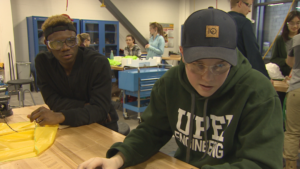
Imagine you’re aboard a massive navy ship in the middle of the windy and wavy Atlantic Ocean while trying to launch a computer attached to a large balloon that has to withstand all of the elements as it travels kilometres into the atmosphere — and your grade depends on it.
That’s what first-year engineering students from the University of Prince Edward Island are doing next week as part of their project this year. They are launching weather balloons from HMCS Halifax with equipment such as sensors, GPS, and cameras to gather data. Students have to design their projects to protect all of the equipment inside while going many kilometres in the air and the harsh conditions of landing in the salty wet Atlantic Ocean.
Think of the egg drop you likely did in grade school — but on a much larger scale.
The Royal Canadian Navy will then use its equipment and rescue boats to help retrieve the projects so the students can read and analyze the data they’ve gathered. Each team of students has come up with an objective for their data.
Maggy McGrath’s team is testing the intensity of UV rays with altitude.
First time Royal Canadian Navy involved in project
“It is really exciting. It’s good to know what engineering is this early on in the process,” she said about the assignment.
Instructor Wayne Peters says there’s always a group project like this, but this year is the most ambitious challenge and the first time the navy is involved.
“We want our students to get real hands on experience,” said Peters, who is also the director of student experience at the School of Sustainable Design Engineering at UPEI.
“They learn how to do certain analysis and engineering. The skills they learn in building. All of these things are the take away skills that they’re going to go with and use in all kinds of other future projects,” he said.
3D printing
Figuring out how to make their projects withstand all of the elements, including being waterproof and not popping with changes to pressure, is giving the students a taste of what engineers do in their professions says UPEI assistant professor Nadja Bressan.
“When we had the idea of this whole project it was based in science and curiosity and actually sending something to space that they could explore,” said Bressan.
She’s optimistic at least half of the 16 weather balloons will be retrieved.
Students are creating and building their projects in a variety of ways including 3D printing.
First-time opportunity for students
Roger Irakoze has included a camera in his project and is figuring out how to make it work with cold temperatures and water.
“These are computer devices and computer devices with water don’t mix very well,” Irakoze said.
Irakoze’s team is checking out sound compared to different temperatures and pressure of the atmosphere.
While team member Godson Oroku said he’s a bit concerned about sea sickness, he said it’s a very exciting opportunity, especially in his first year of school.
“I’ve never been on a navy ship before so it’s really exciting.”
The class has had to apply for a permit from Transport Canada to launch the projects that could travel more than 100 kilometres away. The class plans to travel to Halifax next week to conduct its experiments.
Tune into Compass at 6 p.m. AT to see more on the students’ preparation on Friday and next week as CBC P.E.I. meteorologist Jay Scotland joins the UPEI students on the navy ship.


